In March 2023, the Korean government announced a reorganization plan for the working hours. However, given that it is possible to work up to 69 hours a week, President Yoon’s new reorganization plan has come under heavy criticism that it could encourage an overworked system. On the other hand, unlike the Yoon administration’s steps, the “4-Day work week” is popular around the world these days. Companies and workers clamor for a “4-Day work week,” and there are even countries where the president introduces it to their countries. At this point, we assume everyone agrees that there is a problem with the current working hours. But what matters more is the value and directions to pursue about shortening or extending work time. If so, let’s find out what the 4-Day workweek is, through its concept and cases from Korea and the rest of the world, and step forward to protect the practical labor and work-life balance of our society.
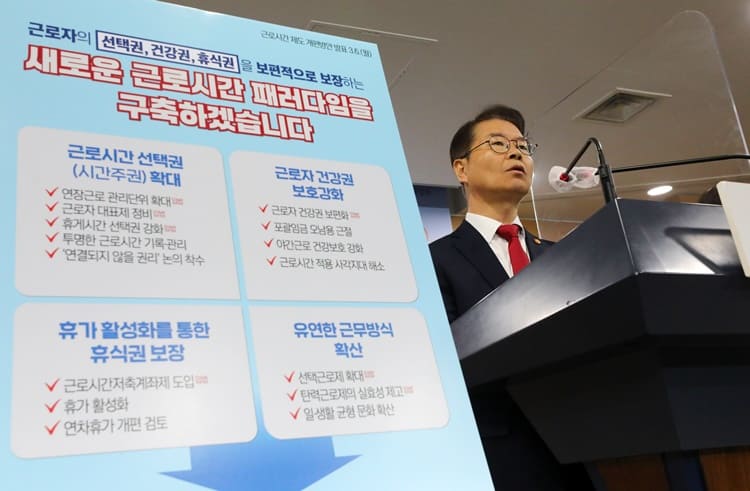 |
NO 69 hours per week, YES 4 days per week
In March 2023, the Ministry of Employment and Labor announced a plan to reorganize the working hour system, saying, “It is to ensure worker’s right to choose, health, and rest.” According to the plan of reorganizing the working hour system by government Yoon, the maximum working hours per week increased arithmetically from the current 52 hours to 69 hours, causing a big controversy. Meanwhile, the current Labor Standard Act stated that working hours can’t exceed 40 hours per week, excluding break time, and 8 hours per day. However, upon agreement, an employee can do his job up to 52 hours per week, 12 hours a day, and at this time the employer must guarantee at least 11 consecutive hours of rest after work until the next day. The reform of the system is promoted under four principles: First, expansion of the right to choose working hours. Second, strengthening the protection of workers’ right to health. Third, guarantee the right to rest by revitalizing breaks. Fourth, the expansion of flexible ways of working. Regarding the government’s reformed plan, the business community and labor unions have asserted conflicting opinions. From the perspective of the business community, the rigid working hour system must be changed and flexible to improve labor productivity. As an example, if there is a need to concentrate on work, such as an increase in the number of orders or a surge in workload, it is difficult to respond with the current 52-hours-per-week system. That’s why they argued that the labor structure needs to be reformed. In other words, the administration of Yoon’s ’69 hours a week’ is intended to work up to 69 hours a week when there are a lot of tasks, and to take a good rest when there are fewer tasks. Whereas, the labor union refutes their claims and said, it is difficult to accept the reform which is packaged as a flexible working hour while increasing the total working hours from the current 52 hours to 69 hours. And it is questionable whether the increase in working hours will improve labor productivity. Furthermore, the labor union protested by stating that they were concerned that a reorganization plan could encourage overwork and long working hours. Regarding this, Yoo Jun-hwan, chairman of the Refresh Labor Council, also known as the MZ generation union, said, “There is a big difference in perception of the word ‘flexible working hours.’ The reorganization plan talks about the total amount of overtime work,” he said. Also, he pointed out, “Generally, when working hours are flexible, the 40 hours statutory working hours are thought to be used freely, so if you work 44 hours a week, you work 36 hours the next week. But no one thinks of working 60 hours this week and 48 hours next week.” In addition, Yoo Jeong-yeop, head of the 2nd policy division of the Federation of Korean Trade Unions, said, “Because people are not machines, regular breaks must be guaranteed for recovery.” He emphasized that “Overtime work is not voluntary between labor and management, but the law should prevent long-term work and protect the right to health.” Yoon Dong-yeol, president of the University Business Administration Association, said, “The reorganization plan laced understanding of the recent social reality that values work and life balances.” “The key to flexible working hours is to reduce working hours while improving productivity. Labor and management should take the lead and come up with a plan that can operate in reality,” he said. As such, there is a negative view of the current government’s new 69-hour work week reform plan. Criticism of the “law to promote overwork” was raised among the youth. Regarding this, Minister of Employment and Labor Lee Jung-sik revealed that the working hour reform plan was being supplemented, saying, “It is unlikely that the working hours will exceed 60 hours a week.” In response to this criticism, the government is taking a submissive attitude. The Ministry of Employment and Labor revealed that it plans to conduct a survey and in-depth interview targeting 6,000 people to gather wide-ranging opinions while preparing supplementary measures to discuss legislation at the regular National Assembly in September. In a condition where even the government is discussing the reform of working hours, interest in the 4-day work week system is rising.
Testing the 4-Day Work Week
Then, what is the 4-day workweek system, and how is it enforced? The 4-day work week works only 4 days a week, in the same context as the change from the 6-day work week to the 5-day work week during the days of former President Kim Dae-jung. The biggest change that appeared after the 5-day work week was increased consumption, and money circulated quickly for hobbies, which increased the supply of jobs accordingly. The positive effect was greater than the side effect that many people were concerned about. After the Covid-19 pandemic, many companies around the world are piloting the 4-day workweek system and receiving positive reviews. Then, let’s look at the movement to promote the 4-day work week through various cases from Korea and globally.
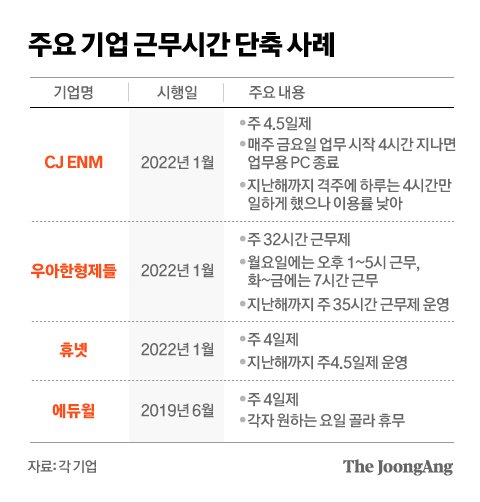 |
Eduwill, a comprehensive education company, has been implementing the 4-day week system in all departments since 2022. Eduwill revealed that the capabilities and work productivity of its employees increased after the implementation of the 4-day workweek system. Kakao Games, a game company, started operating the ‘Playing Friday’ system for the first time in the industry, and SK Group is implementing a 4-day week system with two Fridays off a month through the ‘Happy Friday’ system. Café 24, an e-commerce solution company that exceeded 10 trillion won in transaction volume in 2022, has also been implementing the ‘Off Day’ system, taking off every Friday every other week since last May. Employment Portal Career conducted a survey regarding the number of working days per week for 670 office workers in 2022. As a result, more than 8 out of 10 office workers said they wanted a 4-day work week. Some companies implement not only the 4-day workweek system but also the 4.5-day workweek system. ‘Woowa Bros.’ which runs the food delivery app ‘BaeMin,’ and accommodation platform company Good Choice have established and are implementing a system that allows employees to return to work at 1 pm every Monday after taking a break on the weekend. As companies actively step forward, politicians are also attempting to ride on this trend. In April 2023, Candidate Cho Jung-hoon, who challenged the by-election for the mayor of Seoul made his winning pledge, said, “I will fully support companies that create additional jobs by introducing a 4-day week system.” Another candidate, Park Yong-sun, from Democratic Party, said, “I want to establish a 4.5-day work week. It is connected to various welfare issues such as youth employment issues, women’s lives and childcare, and childcare issues. So, I want to create a new frame for the great transformation of Seoul through this.” However, current Seoul Mayor Oh Se-hoon, who was a candidate at the time, objected to this, saying, “The pledge is to make the youth cry twice.” At the time, candidate Oh said, “As of the end of December last year, the youth unemployment rate was 8.1%, which is twice the general unemployment rate, and there are close to 400,000 young people who just took a break because there are no jobs.” He insisted, “Is the 4.5-day pledge feasible for those who are worried about their livelihood right now?”
 |
The pilot project of Seoul Severance Hospital is a good example of why the 4-day workweek system should be applied first to life safety work or workplaces with high industrial accident rates. A 4-day work week pilot project was started on January 1, 2023, in Severance Hospital. This drew a lot of attention in that it was implemented as the first labor-management agreement in a hospital agreed with the Severance Union. In principle, the union aimed for a 4-day work week without wage cuts, but since it was a small-scale pilot project targeting 30 nurses in 3 wards, a 10% wage cut was agreed with the management for fairness. Nurses routinely show a high resignation rate. The background for this is poor working conditions such as long hours, night shift work, unpaid labor, and emotional labor. According to data released by the Korean Nursing Association in 2022, the resignation rate of new nurses is increasing every year from 42.7% in 2018, 45.5% in 2019, and 27.7% in 2020. Therefore, the 4-day workweek system was implemented as it is in line with the direction of reducing the turnover rate of nurses while ultimately improving the working environment by shortening working hours and improving the quality of nursing services. Nurse Choi Ji-hye (31), who participated in the pilot project, applied for the project while contemplating resignation and said that she had the idea of “either this or leave.” Nurse Choi said, “It’s a job I like, but can I continue doing it? As the years passed, the worries deepened in my heart. However, after experiencing the 4-day work week, it was the first time I thought that I could do this job for decades with the new work system.” Also, “It can’t be said that there are no regrets about the salary cut. However, if the cutoff was about 10%, the satisfaction rose to the square of it. When I worked 5 days a week, I couldn’t do any personal activities, and on holidays I ran out of time to sleep. Because of the 4-day work week, I can exercise and go on a trip during my long rest weeks. It’s something I never dreamed of.” The daily life that nurses regained led to vitality in the workplace. Nurse Lee Hey-jin, another participant, said, “The intensity of daily work is still high. However, the more days I can rest, the more relaxation I feel… As I recovered my physical strength and became emotionally stable, I became more sympathetic to the hearts of patients and guardians… In the meantime, I have recently received a lot of compliment messages from patients.” Lastly, Nurse Choi said, “I understand that hospitals say it is difficult to expand the 4-day week system due to cost issues. Now that I’ve only been doing it for six months, only one-dimensional satisfaction is revealed. Such as being able to exercise and improving my physical strength. However, I think the quality of nursing will improve after 2 or 3 years. There is an expectation that the long-term effect of the 4-day work week system will be much greater than the hospital thinks.” Kim Jong-jin, director of the Working Citizen Research Institute, who is researching the pilot project at Severance Hospital said, “One of the key points of the 4-day work week is to prevent workers on site from leaving due to overwork or long hours of work. And to ensure that skilled workers can stay on the job for a long time. Businesses will recognize the increase of productivity by the 4-day work week system.” He said, “For office management, professional jobs, IT, etc., introducing the 4-day work week can be possible without additional manpower due to increased work efficiency. Like hospitals, additional manpower is needed to operate on a shift basis. To overcome polarized working hours like small and medium-sized enterprises, it is necessary to consider the government’s policy through temporary support.” He added, “It would be nice if it were legislated, but if it is not legislated, we can think of introducing the 4-day week system first through industry-specific agreements centering on industries that matter with life safety such as hospitals or industrial accidents/high-risk workplaces.” Lastly, he hinted at a positive prospect, saying, “If we conduct a pilot project through a tripartite agreement starting from these workplaces, the level of public consent will increase.”
We’re currently implementing it
Like Korean companies, overseas companies are actively spreading the 4-day workweek experiment. In the UK, starting from June to December 2022, 61 companies and 2,900 workers participated in the 4-day workweek project. It was a large-scale project planned by the international non-profit organization ‘4-day week global’ and the think tank ‘Autonomy’ which is a progressive research organization that focuses on climate change and the future of work and economic planning. And analyzed by researchers from Cambridge University, Oxford University, and Boston University. They implemented an average of 34 hours of work per week without reducing workers’ wages. As a result, 56 companies, or 92% of the participating companies said they would continue to maintain the system. Compared to the same period of the previous year, the profits of companies increased by 35% on average, and the number of people who resigned from the company plummeted by 57%. Interestingly the number of workers taking sick leave decreased by 65%, and the company’s profit rate increased by 1.4%. In the case of Japan, it is predicted that the 4-day workweek system will help to strengthen individual capacity to maintain Japanese society and solve the problems of low birth rate and aging population. As of 2022, about 100 employees at ‘Accenture,’ a comprehensive consulting firm in Japan, are implementing a 4-day work week. According to the Nihon Keizai Shimbun, Mr. A 37-year-old employee who joined Accenture as a career worker, said, “Thanks to the efficient work method, I can spend time with my family more precisely.” As the leader of a team of 10 people, Mr. A takes a off day every Wednesday. On days off, he picks up children from the daycare center at 3 pm and spends time with his children about 3 hours earlier than on a normal working day. The consulting industry, such as Accenture, is a place where human capital is immediately competitive, and it is easy to lead to long hours of work. To improve the working environment, they made changes in various ways, such as banning meetings after 6 pm in principle and promoting work automation. As a result, the proportion of female employees increased from 22% to 38%, and the turnover rate was cut in half. Regarding this, an economist from Daiichi Seimei Research Institute emphasized, “If you can use your holidays to invest time in jobs, Japan’s gross domestic product (GDP) will also increase.” A flexible and highly productive work environment must be established for long-term economic development in Korea as well as in Japan, where the population continues to decline.
 |
Reduction of working hours is a global trend, not just in companies. In developed countries of Europe, government-led experiments on the 4-day work week are in full swing, and some countries have already promoted and established it. Iceland is a representative example. The government of Iceland along with the capital Reykjavik City Council experimented with a 4-day week system for 2,500 people, 1% of the total labor population for four years from 2015 to 2019. To begin with the conclusion, this experiment was evaluated as an ’overwhelming success.’ In this experiment, various occupational groups such as kindergarten teachers, office workers, social workers, and hospital workers participated, and the working hours were reduced from 40 hours to 35 hours a week without wage cuts. As a result of the shortening to 36 hours, productivity was maintained or rather improved. Workers’ job satisfaction increased, and their physical, and mental health improved, making great achievements. To reduce working hours and improve efficiency, they wrote the most effective work priorities, tried to reduce meeting time, gave work orders through emails rather than gatherings, reduced teatime, and lean management. And they proved these efforts are possible. Based on this experiment, Icelandic labor unions started renegotiating work methods with companies, and it is now known that 86% of all workers are subject to reduced working hours. Regarding this, according to a report by Autonomy, a think tank, and Iceland Sustainable Democracy Association (ALDA), “Working time reduction is a desirable and feasible policy under today’s high-tech economic structure.” To introduce the case of other countries, in April 2023, in Central Asia Kazakhstan, President Kassim Jomart Tokayev signed the amended labor law that includes a 4-day work week clause. Therefore the 4-day work week will be introduced from July 1, 2023. In principle, Sunday is a holiday for a 4-day worker, but the third day of the week is set to collective agreements or labor regulations. The right to work shifts of about 5- or 6 days a week is guaranteed if labor and management agree. A spokesperson for the Ministry of Labor of Kazakhstan said, “The first week of the month will be a 5-day work week and the second week will be a 4-day work week.” “This cross-work practice is already being applied to white-collar jobs in Kazakhstan and is consistent with international labor standards,” he explained. As such, the change in work efficiency and productivity improvement through the introduction of the 4-day work week in European countries and foreign companies will be a good starting point for discussions on the introduction in Korean companies and public institutions.
Yes, or No?
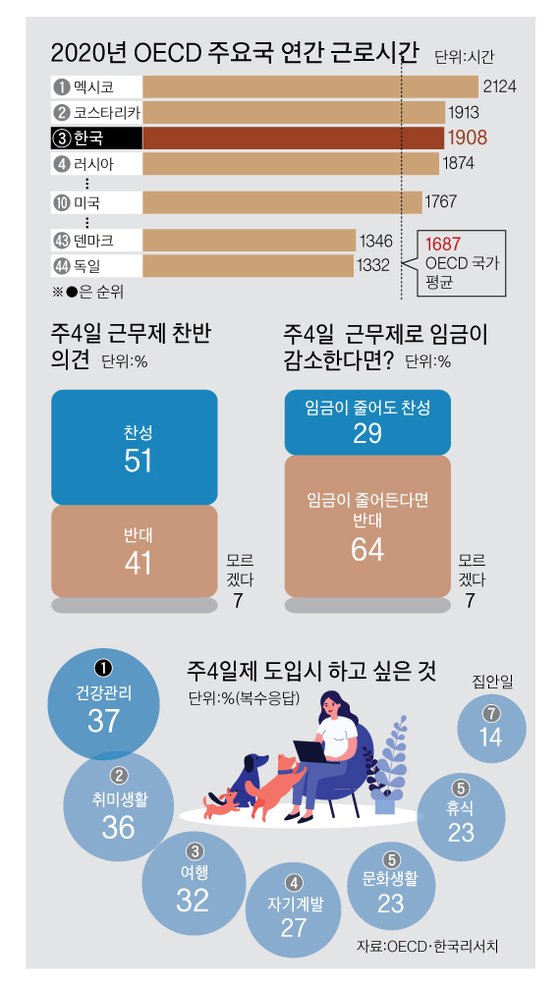 |
Do you think introducing the 4-day workweek is premature? Regarding this claim, the New York Times said, “It has already been discussed a long time ago, and the timing of its introduction is tantalizing.” The 4-day work week was already described as a “not too distant future” by Richard Nixon, Vice President of the United States in 1956. And in 1977, US President Jimmy Carter urged that “businesses should introduce it to save energy.” The Covid-19 pandemic can be cited as the reason for the recent surge in discussion on the 4-day work week. In the past, everyone believed that work efficiency would increase when workers were together in one space, and they did not even think to object to this. However, while people experiencing telecommuting during a pandemic, society has come to realize that the quantity and quality of work do not decline. At the same time, the argument to introduce a 4-day workweek system gained strength as an analysis came out that telecommuting rather increased working hours and fatigue caused by this was the cause of mass resignation. In other words, work efficiency does not decrease even if it is not face-to-face, and it is what workers want to achieve maximum efficiency in a short time rather than lengthening time.
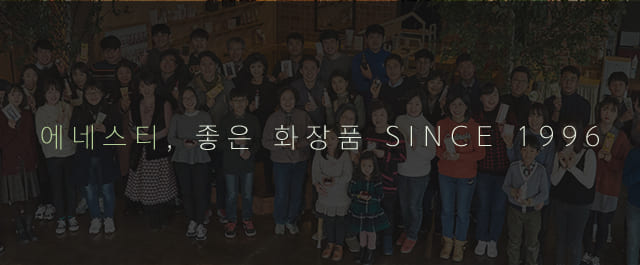 |
As a good example, a domestic cosmetic manufacturer ‘Enesti’, in Chungju, Chungchengbuk-do, Korea, first introduced the 4-day work week in 2010. It was progressively implemented 13 years ago, and the 4-day week system started at the recommendation of a design employee at the time. The system settled down after two years of verification period. Yong Min-gi, marketing team manager at Enesti said, “Since the start of the 4-day work week, there has been no problem with sales declining or the organization becoming cluttered.” Director Yong said that sales have grown for 10 consecutive years and the number of employees has increased from 19 to 40. He said, “As the company became known for values of work life and time with family, the number of applicants increased significantly.” He showed a positive view of the system, saying, “I worked hard to make more sales because I thought there was no company that could protect my work-life balance as well as this company.” Director Yong said that some young employees are moving to larger companies because they have a lot of free time, saying, “But it isn’t a problem. Even if you don’t post it on a job site, there are a lot of job seekers who hear words and apply to us. A system suitable for the 4-day work week is well established, so there is no problem in operating the company if there are competent financial resources.” It was able to get very positive feedback from workers of the 4-day workweek system.
Some people support the 4-day work week, but some oppose it. Regarding the previously introduced pilot project in Iceland, the New York Times cited the disadvantage of a 4-day work week as that it could reduce the sense of belonging and stability among employees. According to the Autonomy report, it is more difficult for managers to organize group activities such as employee training or dinners. And it is pointed out that communication among colleagues is reduced, making it difficult to convey information. Researchers at US polling company Garup said, “As working hours decrease, more employees feel disconnected from their company, team, and manager.” “The fact that there may be an increase in the number of employees who can’t adapt to the organization is a concern for companies sensitive to personnel outflow,” he said. Also, it is difficult to introduce the case of Iceland to Korea because it has a much larger population density and a much larger economy than Iceland and has a complex industrial structure. Another opinion is that if the 4-day workweek system is introduced in the current working environment, only regular workers in high-income industries will benefit from it. The so-called ‘labor polarization’ problem can be raised. Some point out that the system will further widen the labor gap in a situation where low wages and wage inequality are severe. And the number of workers who are not subject to legal working hours, such as special employment positions and platform workers will increase. In addition, Seo Yong-gu, a professor of business administration at Sookmyung Women’s University, said, “With Covid-19, the gap between jobs that allow non-face-to-face work and jobs that require facing contact has widened.” In response to the argument that work efficiency is expected to improve despite reduced working hours, the counterargument says that productivity will decrease, and more manpower will be needed. Then, it will increase the labor cost burden.
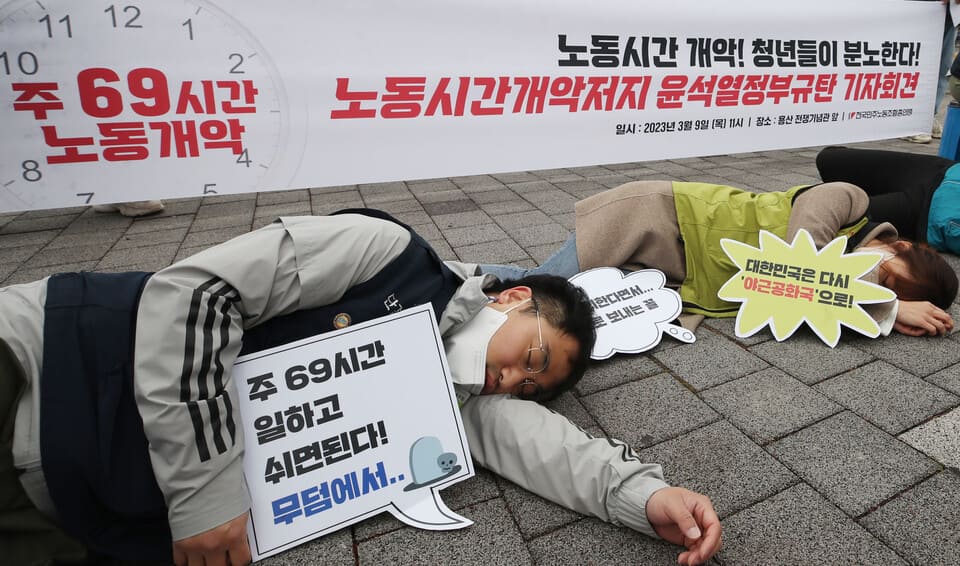 |
There is also opposition to the 69-hour work reform plan. From the beginning of his inauguration, President Yoon promised to “expand youth participation in state affairs,” and the pledge to reflect the position of young people from the policy establishment process is being reflected in state affairs. As various complaints poured out from each class over the flexible working time policy. President Yoon said, “It is necessary to see all policies from the perspective of the MZ generation and youth. The MZ generation plays a role in leading the public opinion of all generations,” and once again tried to embrace the younger generation. However, criticism from the MZ generations in their 20s on the flexible working hour policy grew bigger day by day. Mr. Choi, in his 20s, said, “Once I get the benefit of flexible working hours, other colleagues will be busy when I take a break, and then I won’t be able to take a proper break mentally.” “I don’t know if the government has taken into account the fact that I could be busy again when others are off,” he said. Mr. Ahn, an employee of a large company, pointed out that “the flexible commuting system was introduced at our company, but it is not being followed properly…I hope that the current system will be well maintained.” Mr. Kang said, “The first thing I thought of when I saw the flexibility of working hours was that it was a retrogressive trickery policy. Europe is introducing a 4-day work week but isn’t it right to reduce working hours?'' By saying this, he directly complained about current working hours. Jin Mo, an employee of another major company, said, “They say that flexible working hours is a policy for the MZ generation, but I got the feeling that the MZ generation doesn’t know what they want. Is it possible to have flexible working hours in a situation where you can’t even take vacations, which you can see?” expressed the real problems in the working site.
 |
The global effort to transition to a 4-day work week has been going on for a long time, and Covid-19 somehow has accelerated it. Some politicians even put forward a 4-day work week as a pledge. These steps of change will come as a rejection to some and good news to others. Even if it is not the 4-day system, everyone is voicing their agreement on the reorganization of working hours. However, since there are advantages and disadvantages to all of them, many experiments and studies will be needed to establish the most suitable working hours in Korea.
May 1st is International Labor Day. It is a holiday established to comfort workers for their hard work and to increase their motivation to work. The workers are me and my family, not anyone else. What the workers need, and the way for them will soon be the way to save the economy, society, and even the country. "Monday, Tuesday, Wednesday, Thursday, Sunday, Sunday, and Sunday" will soon come to our reality, and it is now up to us to decide what value to pursue and how to balance 'work and life.'
고주선 kojs3716@inha.edu






